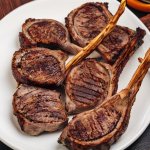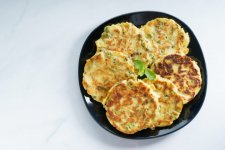Menu
Install the app
How to install the app on iOS
Follow along with the video below to see how to install our site as a web app on your home screen.
Note: This feature may not be available in some browsers.
You are using an out of date browser. It may not display this or other websites correctly.
You should upgrade or use an alternative browser.
You should upgrade or use an alternative browser.
Greek Food, Cooking and Recipe Community
What makes Greek pita Greek?
- Thread starter auroracoor1
- Start date
1 - 4 of 4 Posts
dpappas87
Active member
It doesn't quite look like the picture you posted, it's more like the one in the gyro picture below. It does get confusing, especially if you don’t have any Greek supermarkets nearby and you’re buying from American supermarkets or middle eastern or general european supermarkets. Greek pita is fluffier, thicker and is lighter in color.


k_tsoukalas
Administrator
Hey I think the picture you posted is something different. There's a Greek dish that's more like a pancake, but not like the pancakes we have here in the United States. It's savory, more like a fried bread, and the pancakes don't use yeast. The batter is very similar to an American pancake, but a little thinner so they don't fry up as fluffy as an American pancake. Greek pita bread is fluffier than other types of pita bread you can get in the store. It's used to make gyros, and they do use yeast.


axariotisxy
Member
Yes, I believe the one in the original picture is tiganopita with feta. The real Greek pita is in this picture!Hey I think the picture you posted is something different. There's a Greek dish that's more like a pancake, but not like the pancakes we have here in the United States. It's savory, more like a fried bread, and the pancakes don't use yeast. The batter is very similar to an American pancake, but a little thinner so they don't fry up as fluffy as an American pancake. Greek pita bread is fluffier than other types of pita bread you can get in the store. It's used to make gyros, and they do use yeast.
View attachment 128
1 - 4 of 4 Posts
JOIN THE DISCUSSION AND READ OTHER GREEK INFO:
Bougatsa Recipe - Delicious Breakfast!
- dimi_pat
- Greek Food Forum
- Replies: 0
When I was in Greece, I loved having bougatsa for breakfast. I don't have it much when I am back home so I decided to learn how to make it. Here's the recipe I use:
I do have a question, I find using the puff pastry the easiest. However, what do they use in Greece?
Dough:
I do have a question, I find using the puff pastry the easiest. However, what do they use in Greece?
Dough:
- 1 package (about 17.3 ounces) frozen puff pastry sheets, thawed
- 1/2 cup (1 stick) unsalted butter, melted
- 4 cups whole milk
- 1 cup granulated sugar
- 1 cup fine semolina flour
- 4 large eggs
- 1 teaspoon vanilla extract
- Powdered sugar, for dusting (optional)
- Ground cinnamon, for sprinkling (optional)
- Prepare the Custard Filling:
- In a medium saucepan, heat the milk over medium heat until it's hot but not boiling.
- In a separate bowl, whisk together the sugar, semolina flour, eggs, and vanilla extract until well combined.
- Gradually pour about 1/4 of the hot milk into the egg mixture, whisking constantly to temper the eggs.
- Pour the tempered egg mixture back into the saucepan with the remaining hot milk, whisking constantly.
- Cook the mixture over medium heat, stirring constantly, until it thickens to a custard-like consistency, about 5-7 minutes. Remove from heat and let it cool slightly.
- Prepare the Bougatsa Dough:
- Preheat your oven to 375°F (190°C). Line a baking sheet with parchment paper.
- Unfold the thawed puff pastry sheets onto a clean surface. Brush melted butter generously over one sheet of puff pastry.
- Place the second puff pastry sheet on top of the buttered one. Brush the top with more melted butter.
- Roll up the puff pastry sheets tightly into a log. Cut the log into 12 equal portions.
- Assemble the Bougatsa:
- Take one portion of the puff pastry and flatten it into a thin circle on a floured surface, using a rolling pin.
- Place about 2-3 tablespoons of the cooled custard filling in the center of the pastry circle.
- Fold the edges of the pastry circle over the custard filling, creating a sealed pouch. Place the filled bougatsa onto the prepared baking sheet.
- Repeat this process with the remaining puff pastry portions and custard filling.
- Bake the Bougatsa:
- Place the baking sheet in the preheated oven and bake the bougatsa until the pastry is golden brown and crispy, about 25-30 minutes.
- Remove the bougatsa from the oven and let it cool slightly before serving.
Creative ideas for Easter lamb leftovers?
- mastichas09
- Greek Food Forum
- Replies: 0
We cooked too much Easter lamb than we needed and have a ton leftover. I am sure I am not the only one! I am brainstorming ways to use the leftovers. Do you guys have anything to add?
1. Gyros with lamb (Tzatziki and all the trimmings!)
2. Lamb sandwiches
3. Stir fries
4. Lamb in rice and tomato sauce
5. Wraps
6. Omelets and scrambles (think steak and eggs, but with Greek flavors and of course lamb instead of steak)

1. Gyros with lamb (Tzatziki and all the trimmings!)
2. Lamb sandwiches
3. Stir fries
4. Lamb in rice and tomato sauce
5. Wraps
6. Omelets and scrambles (think steak and eggs, but with Greek flavors and of course lamb instead of steak)

Tips to Prevent Phyllo from Drying Out?
- auroracoor1
- Greek Food Forum
- Replies: 0
I am not new with working with phyllo.
Lately, and I don't know why, the phyllo has been during out as I work with it. It's always store bought phyllo and it may be another brand than what I normally use, but I don't see how that could possibly make a difference.e Perhaps I am working slower. Maybe my kitchen is dryer.
All I know is that I would love some tips on how to prevent the phyllo from drying out! I asked around and people say to keep a wet towel over it. I tried that and the phyllo stuck to the towel so I am obviously missing an important detail.
Lately, and I don't know why, the phyllo has been during out as I work with it. It's always store bought phyllo and it may be another brand than what I normally use, but I don't see how that could possibly make a difference.e Perhaps I am working slower. Maybe my kitchen is dryer.
All I know is that I would love some tips on how to prevent the phyllo from drying out! I asked around and people say to keep a wet towel over it. I tried that and the phyllo stuck to the towel so I am obviously missing an important detail.
Top herbal teas popular in Greece?
- nm1999
- Greek Food Forum
- Replies: 2
Could anyone share insights or recommendations on which herbal teas are the most popular or cherished in Greece? I'm particularly interested in teas that are unique to the region or have a special place in Greek culture and wellness practices.
Also, if you have any suggestions on where I might purchase these teas, especially if they're available online, that would be incredibly helpful! I'm eager to try making some of these teas at home and experiencing a taste of Greek herbal tradition.
Thank you in advance for your help! I’m looking forward to exploring your suggestions and hopefully discovering some new favorite teas.
Also, if you have any suggestions on where I might purchase these teas, especially if they're available online, that would be incredibly helpful! I'm eager to try making some of these teas at home and experiencing a taste of Greek herbal tradition.
Thank you in advance for your help! I’m looking forward to exploring your suggestions and hopefully discovering some new favorite teas.
Cumin in Greek Cooking?
- d_kakavouli
- Greek Food Forum
- Replies: 0
When I was in Greece, I bumped into a "spanakopita" in like a turnover style dough. It didn't have cheese and was spiced with cumin. I hadn't realized people use Cumin in Greece until I tasted it in this dish. I was kind of confused.
Do people actually use cumin in Greek cooking? None of the old recipes I have mention it. Could it be a more modern influence?
Do people actually use cumin in Greek cooking? None of the old recipes I have mention it. Could it be a more modern influence?
Sign up for a free account and share your thoughts, photos, questions about Greek food, travel and culture!
WorldwideGreeks.com is a free online forum community where people can discuss Greek food, travel, traditions, history and mythology.
Join Worldwide Greeks here!
Join Worldwide Greeks here!
JOIN COMMUNITY FOR FREE
LOGIN TO YOUR ACCOUNT



